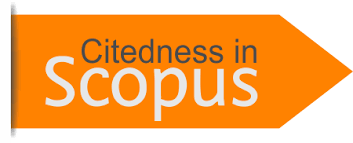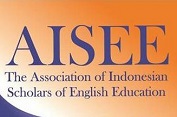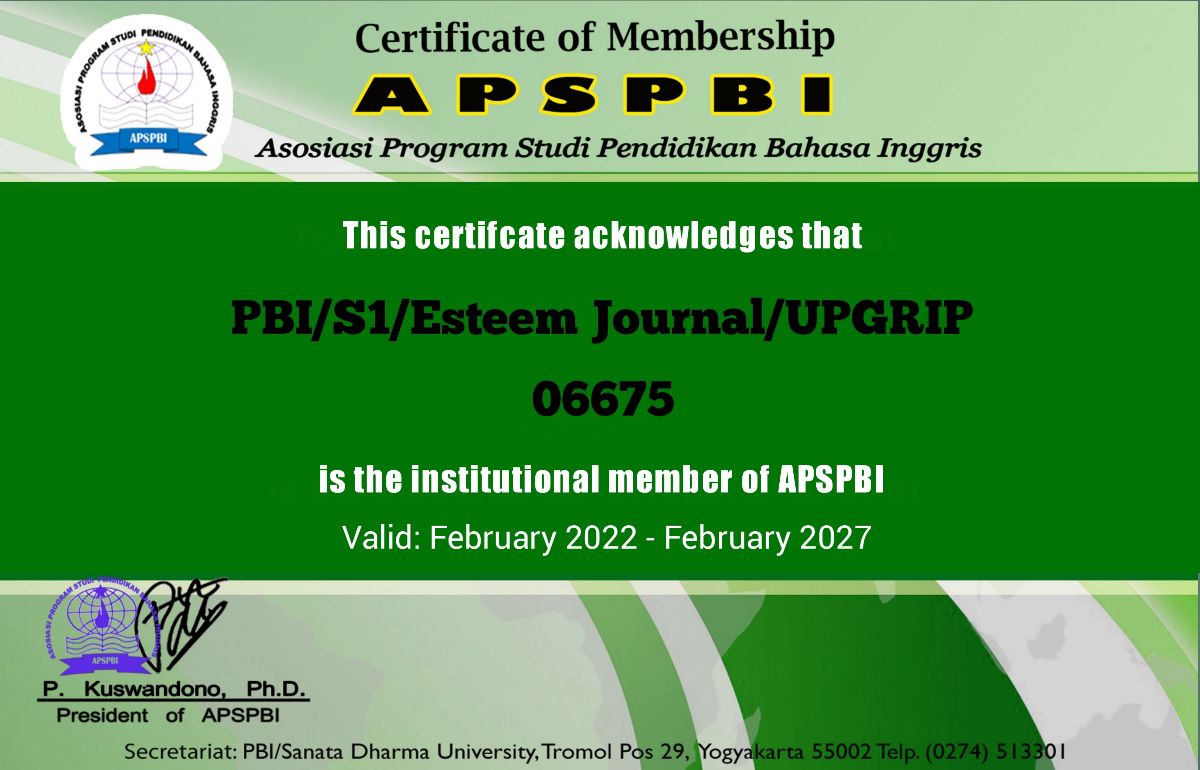QUILLBOT AS AN ALTERNATIVE WRITING TOOL: EXAMINING ITS USES ON THE ACADEMIC WRITING PERFORMANCE OF EFL LEARNERS
DOI:
https://doi.org/10.31851/esteem.v7i2.15254Keywords:
Artificial Intelligence, QuillBot, Writing tool, Academic writing, EFL LearnerAbstract
This study aimed to assess whether the use of QuillBot enhanced the academic writing skills of EFL learners in the English Education Department at Universitas Muhammadiyah Sumatera Utara. Pre-experimental design was implemented in this research. The participants in the research were selected from a class of 20 English as a Foreign Language (EFL) learners who had recently completed their academic writing classes the previous semester. Data from the pre-test and post-test was collected and a t-test was used for analyses using SPSS 29.0 version. This test consisted of an academic writing test about things that transpired in the educational sphere. The pre-test score reached 123, while the post-test score was 285. The data demonstrates that the t-test result was 56.53. The significance level of a = 0.05. The results determined that Sig (2-tailed) 0.000 is the probability value for the pre-test and post-test data for the EFL academic writing performance by using QuillBot. H0 is rejected since the probability (Sig.) 0.000 < 0.05. Furthermore, the results strongly indicate that QuillBot has greatly enhanced EFL learners' academic writing skills.
References
Alammar, A., & Amin, E.A. (2023). EFL Students' Perception of Using AI Paraphrasing Tools in English Language Research Projects. Arab World English Journal, 14 (3) 166-181. https://dx.doi.org/10.24093/awej/vol14no3.11
AlMarwani, M. (2020). Academic Writing: Challenges and Potential Solutions. Arab World English Journal (AWEJ) Special Issue on CALL (6). 114-121. https://dx.doi.org/10.24093/awej/call6.8
Brown, T.B., Mann, B., Ryder, N., Subbiah, M., Kaplan, J., Dhariwal, P., Neelakantan, A., Shyam, P., Sastry, G., Askell, A., Agarwal, S., Herbert-Voss, A., Krueger, G., Henighan, T., Child, R., Ramesh, A., Ziegler, D. M., Wu, J., Winter, C. & Amodei, D. (2005). Language models are few-shot learners. arXiv. Computer Science, Computation and Language.
Chen, M. H., Huang, S. T., Chang, J. S., & Liou, H.C. (2015). Developing a corpus-based paraphrase tool to improve EFL learners’ writing skills. Computer Assisted Language Learning, 28(1), 22–40. https://doi.org/10.1080/09588221.2013.783873
Creswell, J. W. (2009). Research Design: Qualitative, Quantitative, and Mixed Methods Approaches (3rd ed.). Thousand Oaks, CA: Sage Publications.
Dahl, B. M., Vasset, F., & Frilund, M. (2023). Students’ approaches to scientific essay writing as an educational method in higher education: A mixed methods study. Social Sciences & Humanities Open, 7. 2590-2911. https://doi.org/10.1016/j.ssaho.2022.100389
Dale, R. (2020). Natural language generation: The commercial state of the art in 2020. Natural Language Engineering, 26(4), 481–487. https://doi.org/10.1017/S135132492000025X
Dimitrov, D.M., & Rumrill, P. D. Jr. (2003). Pretest-posttest designs and measurement of change. Work 20(2):159-65. Sage Publications.
Fitria, T. N. (2021). QuillBot as an online tool: Students’ alternative in paraphrasing and rewriting of English writing. Englisia: Journal of Language, Education, and Humanities, 9(1), 183-196. http://dx.doi.org/10.22373/ej.v9i1.10233
Gebremariam, H. T., & Hiluf, B. (2023). Using need-based writing instruction through self-reflection to improve students’ writing difficulties: A counterbalanced design. International Journal of Educational Research Open, 5. 2666-3740. https://doi.org/10.1016/j.ijedro.2023.100293
Hein, T. T. T. (2024). AI tools in teaching and learning English academic writing skills. Proceedings of the AsiaCALL International Conference, 4, 170-187. ISSN: 2833-6836; ISBN: 979-8-9870112-4-9. DOI: https://doi.org/10.54855/paic.23413
Husin, M, Said., & Nurbayani, E. (2017). “The Ability of Indonesian EFL Learners in Writing Academic Papers.” Dinamika Ilmu, 17(2):237–50. https://doi.org/10.21093/di.v17i2.725
Hwang, G., Xie, H., Wah, B. W. & Gasevic, D. (2020). Vision, challenges, roles and research issues of Artificial Intelligence in Education. Computers and Education: Artificial Intelligence, 1.2666-920X. https://doi.org/10.1016/j.caeai.2020.100001
Jabali, O. (2018). Students’ attitudes towards EFL university writing: A case study at An-Najah National University, Palestine. Heliyon. https://doi.org/10.1016/j.heliyon.2018.e00896
Kim, G. Y., Yang, D., Reyes, M., & Connor, C. (2021). instruction improves students’ writing skills differentially depending on focal instruction and children: A meta-analysis for primary grade students. Educational Research Review, 34. 1747-938X. https://doi.org/10.1016/j.edurev.2021.100408
Kinga, S., & Gupta, G. S. (2021). Platforms as foundation of sharing economy. Delhi Business Review, 22(1), 1–13. https://doi.org/10.51768/dbr.v22i1.221202101
Lin, L. H. F., & Morrison, B. (2021). Challenges in academic writing: Perspectives of Engineering faculty and L2 postgraduate research students. English for Specific Purposes, 63, 59–70. https://doi.org/10.1016/j.esp.2021.03.004
Mackey, & Gass. (2021). Second Language Research Methodology and Design (3rd Edition). Routledge. https://doi.org/https://doi.org/10.4324/9781003188414
Mohammad, T., Alzubi, A. A. F., Nazim, M., & Khan, S. I. (2023). EFL paraphrasing skills with QuillBot: Unveiling students' enthusiasm and insights. Journal of Pedagogical Research, 7(5), 359-373. https://doi.org/10.33902/JPR.202324645
Mohammad, T., Alzubi, A. A. F., Nazim, M., & Khan, S. I. (2023). EFL paraphrasing skills with QuillBot: Unveiling students' enthusiasm and insights. Journal of Pedagogical Research. 7(5), 359-373. https://doi.org/10.33902/JPR.20232464
Muijs, D. (2022). Doing Quantitative Research in Education with IBM SPSS Statistics. In Doing Quantitative Research in Education with IBM SPSS Statistics.
Nazari, N., Shabbir, M. S., & Setiawan, R. (2021). Application of Artificial Intelligence powered Digital Writing Assistant in higher education: randomized controlled trial. Heliyon, 7.2405-8440. https://doi.org/10.1016/j.heliyon.2021.e07014
Niemi, H. (2021). AI in learning: Preparing grounds for future learning. Journal of Pacific Rim Psychology, 15: 1–12. https://doi.org/10.1177/18344909211038105
Popenici, S. A. D., & Kerr, S. (2017). Exploring the impact of artificial intelligence on teaching and learning in higher education. Research and Practice in Technology Enhanced Learning,12:22. http://doi.org/10.1186/s41039-017-0062-8
Rahayu, S. (2023). The Impact of Artificial Intelligence on Education: Opportunities and Challenges. Jurnal Educatio FKIP UNMA, 9(4), 2132–2140. https://doi.org/10.31949/educatio.v9i4.611
Seo, K., Tang, J., Roll, I., Yoon, D. (2021). The impact of artificial intelligence on learner–instructor interaction in online learning. International Journal of Educational Technology in Higher Education. 18, 54. https://doi.org/10.1186/s41239-021-00292-9
Shi, L. (2012). Rewriting and paraphrasing source texts in second language writing. Journal of Second Language Writing, 21. 134–148. http://dx.doi.org/10.1016/j.jslw.2012.03.003
Siekmann, L., Parr, J. M., & Busse, V. (2022). Structure and coherence as challenges in composition: A study of assessing less proficient EFL writers’ text quality. Assessing Writing, 54. 1075-2935. https://doi.org/10.1016/j.asw.2022.100672
Tseng, W & Warschaue, M. (2023). AI-writing tools in education: if you can’t beat them, join them, Journal of China Computer-Assisted Language Learning. 3(2): 258–262. https://doi.org/10.1515/jccall-2023-0008
Utami, S. P. T., Andayani, Winarni, R., & Sumarwati. (2023). Utilization of artificial intelligence technology in an academic writing class: How do Indonesian students perceive?. Contemporary Educational Technology, 15(4), ep450. https://doi.org/10.30935/cedtech/13419
Wen, X & Walters, S, M. (2022). The Impact of Technology on Students’ Writing Performances in Elementary Classrooms: A Meta-Analysis. Computers and Education Open. 3. 2666-5573. https://doi.org/10.1016/j.caeo.2022.100082
Yilmaz, R., & Karaog Yilmaz, F. G. (2023). The effect of generative artificial intelligence (AI)-based tool use on students’ computational thinking skills, programming self-efficacy, and motivation. Computers and Education: Artificial Intelligence, 4. 2666-920X/. https://doi.org/10.1016/j.caeai.2023.100147
Zawacki-Richter, O., Marín, V.I., Bond, M., Gouverneur, F., (2019). Systematic review of research on artificial intelligence applications in higher education – where are the educators?. International Journal of Educational Technology in Higher Education. 16:39.2-27. https://doi.org/10.1186/s41239-019-0171-0
Downloads
Published
Issue
Section
License
Copyright (c) 2024 Yoandita, Yenni Hasnah

This work is licensed under a Creative Commons Attribution-NonCommercial-ShareAlike 4.0 International License.
Copyright Notice
Authors who publish with this journal agree to the following terms:
In order to assure the highest standards for published articles, a peer review policy is applied. In pursue of the compliance with academic standards, all parties involved in the publishing process (the authors, the editors and the editorial board and the reviewers) agree to meet the responsibilities stated below in accordance to the Journal publication ethics and malpractice statement.
Duties of Authors:
- The author(s) warrant that the submitted article is an original work, which has not been previously published, and that they have obtained an agreement from any co-author(s) prior to the manuscript’s submission;
- The author(s) should not submit articles describing essentially the same research to more than one journal;
- The authors(s) make certain that the manuscript meets the terms of the Manuscript Submission Guideline regarding appropriate academic citation and that no copyright infringement occurs;
- The authors(s) should inform the editors about any conflict of interests and report any errors they subsequently, discover in their manuscript.
Duties of Editors and the Editorial Board:
- The editors, together with the editorial board, are responsible for deciding upon the publication or rejection of the submitted manuscripts based only on their originality, significance, and relevance to the domains of the journal;
- The editors evaluate the manuscripts compliance with academic criteria, the domains of the journal and the guidelines;
- The editors must at all times respect the confidentiality of any information pertaining to the submitted manuscripts;
- The editors assign the review of each manuscript to two reviewers chosen according to their domains of expertise. The editors must take into account any conflict of interest reported by the authors and the reviewers.
- The editors must ensure that the comments and recommendations of the reviewers are sent to the author(s) in due time and that the manuscripts are returned to the editors, who take the final decision to publish them or not.
Authors are permitted and encouraged to post online a pre-publication manuscript (but not the Publisher final formatted PDF version of the Work) in institutional repositories or on their Websites prior to and during the submission process, as it can lead to productive exchanges, as well as earlier and greater citation of published work (see The Effect of Open Access). Any such posting made before acceptance and publication of the Work shall be updated upon publication to include a reference to the Publisher-assigned DOI (Digital Object Identifier) and a link to the online abstract for the final published Work in the Journal.





























